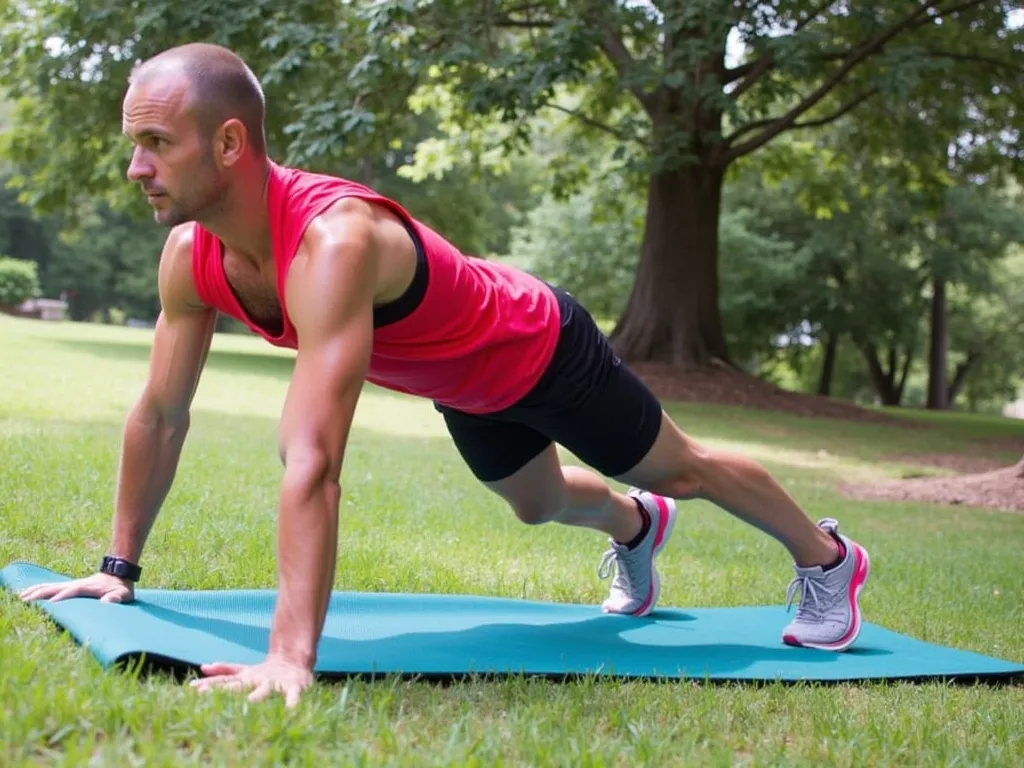How do you build strength for running? You need 2-3 weekly sessions focused on compound movements like squats and deadlifts, combined with core stability work and proper recovery. This guide provides the exact exercises and schedule to boost your running economy by 8-12% and slash injury risk.
🔑 Key Takeaways
- 2-3 Sessions: Strength training 2-3 times weekly improves running economy by 8-12%.
- Injury Shield: Corrects muscle imbalances and strengthens connective tissues, reducing common running injuries by up to 50%.
- Core First: A stable core from planks and dead bugs is non-negotiable for maintaining form and efficiency.
- Progressive Overload: Systematically increase weight, reps, or sets every 3-4 weeks to avoid plateaus.
- 48-Hour Rule: Allow at least 48 hours of recovery between intense strength sessions for optimal adaptation.
Why Strength Training is Essential for Runners

Running demands more than just cardiovascular endurance. A comprehensive training approach that includes strength work is proven to enhance performance and reduce injury risk.
The Science Behind Strength Training for Runners
Research published in the Journal of Strength and Conditioning Research shows that runners who incorporate strength training 2-3 times per week experience:
- 8-12% improvement in running economy.
- Enhanced power output and sprint speed.
- Increased muscular endurance for late-race performance.
- Optimized running form and efficiency.
- An overall boost in athletic performance.
Injury Prevention
- Strengthens tendons and ligaments (connective tissues).
- Corrects muscle imbalances between quads and hamstrings.
- Improves stability in knees, hips, and ankles.
- Reduces risk of IT band syndrome, runner’s knee, and shin splints.
- Enhances recovery between hard running sessions.
Essential Strength Exercises for Runners

Upper Body Workouts
- Push-ups
- Sets: 2-3
- Reps: 10-15
- Benefits: Improves posture and arm drive for hill running.
- Form tips: Keep core tight, elbows at a 45-degree angle.
- Dumbbell Rows
- Sets: 2-3
- Reps: 12 each side
- Benefits: Strengthens back muscles to counter forward lean.
- Form tips: Maintain a neutral spine, squeeze shoulder blades.
- Tricep Dips
- Sets: 2-3
- Reps: 12-15
- Benefits: Enhances arm strength for maintaining cadence.
- Form tips: Keep elbows pointing backward, don’t sink too low.
Core Strengthening
Core stability training is crucial for maintaining proper form during long runs. Include:
- Planks: 3 sets of 30-60 seconds.
- Russian Twists: 2 sets of 20 reps (with weight if advanced).
- Dead Bugs: 2 sets of 12 reps each side for anti-rotation stability.
Lower Body Exercises
- Goblet Squats
- Sets: 2-3
- Reps: 12-15
- Benefits: Builds foundational leg and glute power.
- Form tips: Keep chest up, descend until thighs are parallel to floor.
- Walking Lunges
- Sets: 2
- Reps: 10 each leg
- Benefits: Improves single-leg strength and running stability.
- Form tips: Keep torso upright, step far enough to create 90-degree angles.
- Single-leg Romanian Deadlifts
- Sets: 2-3
- Reps: 10-12 each side
- Benefits: Develops balance and strengthens hamstrings and glutes.
- Form tips> Hinge at hips, maintain a straight back, slight knee bend.
Plyometric & Power Exercises
- Box Jumps
- Sets: 2-3
- Reps: 6-8
- Benefits: Develops explosive power for sprinting and hill climbs.
- Skater Jumps
- Sets: 2
- Reps: 10 each side
- Benefits: Improves lateral agility and single-leg stability.
Resistance Band Training for Runners
Benefits
- Portable and lightweight for training anywhere.
- Provides variable resistance for progressive overload.
- Excellent for activating glutes in warm-up routines.
- Targets running-specific stabilizer muscles.
Key Exercises
- Monster Walks
- Sets: 2-3
- Reps: 10 steps each direction
- Benefits: Strengthens hip abductors to prevent knee valgus.
- Banded Glute Bridges
- Sets: 2-3
- Reps: 15-20
- Benefits: Adds resistance to maximize glute activation.
- Lateral Band Walks
- Sets: 2
- Reps: 15 steps each direction
- Benefits: Directly improves hip stability for the stance phase of running.
Progressive Overload Principles for Runners
Proper training progression is essential for avoiding plateaus and injuries. Follow these guidelines from the principle of progressive overload:
- Increase resistance (weight) by ~5% when you can complete the top of your rep range with good form.
- Progress from bodyweight to weighted exercises (e.g., bodyweight squat to goblet squat).
- Increase volume by adding 1-2 reps or an extra set every 3-4 weeks.
- Decrease rest time between sets as your work capacity improves.
Recovery and Integration
Rest Periods
- Allow 48 hours between heavy strength sessions targeting the same muscle groups.
- Focus on active recovery methods like foam rolling or light swimming.
- Listen to your body’s signals—persistent soreness means you need more rest.
Nutrition Tips
- Consume 20-30g of protein within 30 minutes post-workout for muscle repair.
- Stay hydrated; even 2% dehydration can impair strength and recovery.
- Follow proper nutrition guidelines to fuel both running and strength adaptations.
Training Schedule Integration

Sample Weekly Schedule
- Monday: Interval Running + Upper Body & Core Strength
- Tuesday: Easy Recovery Run
- Wednesday: Tempo Run + Lower Body & Plyometric Strength
- Thursday: Rest or Cross-training (swimming, cycling)
- Friday: Easy Run + Core & Resistance Band Work
- Saturday: Long Run
- Sunday: Complete Rest or Light Mobility Work
Form and Technique Tips
Proper form during strength training is crucial for preventing common running injuries:
- Maintain a neutral spine in all lifts.
- Control movements on both the concentric and eccentric phases.
- Focus on mind-muscle connection, especially for glute activation.
- Perfect form with bodyweight before adding external load.
Common Mistakes to Avoid
- Skipping a dynamic warm-up.
- Increasing weight or mileage too aggressively.
- Neglecting sleep and nutrition for recovery.
- Being inconsistent—2 consistent sessions are better than 4 sporadic ones.
- Ignoring mobility work for hips and ankles.
Advanced Training Considerations
Periodization
- Vary intensity and volume in 4-6 week blocks (mesocycles).
- Adjust strength focus based on your race schedule (base building vs. peak phase).
- Follow a structured training plan that integrates running and strength cycles.
Conclusion
Strength training is the most effective upgrade for your running. It directly improves economy, power, and durability. Start with 2 sessions per week, focusing on compound lower-body lifts and core stability. Apply progressive overload consistently. Prioritize recovery as part of your training. The result is not just faster times, but a more resilient body that can handle higher mileage with less risk. Your next step is to implement the sample weekly schedule for the next 4 weeks and track your running feel and performance.
❓ Frequently Asked Questions
Will strength training make me bulky and slow?
No. The rep ranges (8-15) and focus on compound movements in this guide build functional strength and power without significant muscle mass gain. This improves running economy, making you more efficient and faster.
Should I run or do strength training first?
Prioritize based on your goal for the day. If it’s a key running session (intervals, long run), run first. If it’s a strength-focused day, lift first. Always separate intense running and heavy lifting by at least 6 hours if done on the same day.
How long until I see improvements in my running?
Most runners notice improved stability and form within 3-4 weeks. Measurable improvements in running economy and race performance typically become evident after 8-12 weeks of consistent, progressive strength training.
Can I do this at home without a gym?
Yes. Use bodyweight exercises (push-ups, squats, lunges), core work, and resistance bands. For progressive overload, use a backpack with books for weight or switch to more challenging variations like pistol squat progressions.
Is it okay to be sore from strength training before a run?
Light muscle soreness (DOMS) is fine. Do an easy, gentle run to promote blood flow and recovery. If you have sharp pain or joint discomfort, take a rest day. Schedule your hardest runs for days after your lightest strength sessions.
References
- Strength training for runners: Top 10 workout exercises – Red Bull
- Strength training for runners – your how-to guide – Runner’s World UK
- Lifting Weights for Runners: The Ultimate Guide (2026) – Strength Running
- Effects of Strength Training on Running Economy – Journal of Strength and Conditioning Research
- How to Build Muscle Strength: A Complete Guide – Healthline
